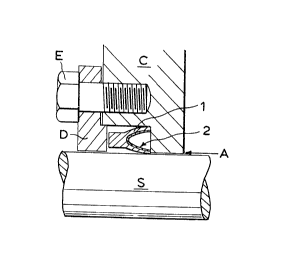Note: Descriptions are shown in the official language in which they were submitted.
1~65547
"IMPROVEMENTS RELATING TO RING SEALS"
This invention relates to ring seals of the kind
comprising an annular jacket of relatively yieldable
material which is of channel shaped radial cross-section
and to which resilience is imparted by an internal
energising spring ring which is located in the channel.
The jacket may be made of material having a low friction
co-efficient such as Teflon (Registered Trade Mark).
The spring may be made of either metal or elastomer in
various configuration~. It may thus be of helically
coiled construction or of channel shaped radial
cross-section. In our ~ patent a~Uk.~u~
no. ~s~9 there is proposed a ring seal of the kind
referred to for static sealing purposes.
Such ring seal6 may be used as static seals, that is
to say for sealing between two static mating face~ or as
dynamic seals that is to say for ~ealing, externally or
internally, reciprocating or rotating shafts in relation
to adjacent tubes, casings or the like.
The present invention is concerned however with
dynamic ring sealing and has been devised with the
object of providing an inproved dynamic ring seal of the
kind referred to which is less liable to failure by
metal spring fatigue or dislodgement of the spring from
the jacket.
~265547
Some tyyical embodiments of the invention are
illustrated in the accompanying drawings and will
hereinafter be described.
In these drawings:
Figs. l to g inclusive are fragmentary sectional
views which respectively show the Eour different
embodiments in a typical working environment;
Figs. 5. 6 and 7 are radial sections of energising
spring rings which Iespectively form ~art of the
sealing rings illustrated in Figs. l to 3;
Fig. 8 is a diametric section through an energising
spring ring showing its mode of construction; and
Fig. 9 is a side elevation of the energising spring
ring a~ shown in Fig. 8.
~5 In each of Figs. l to ~ inclusive there is shown a
rotating or reciprocating shaft F which projects
rotating end wall C. This end wall has an annular
cavity which accommodates the sealing ring and the
sealing ring is held in place by an annulus D which is
tightened on to the casing wall C by means of a stud E.
In each instance the sealing ring comprises an outer
machined jacket made of relatively yieldable,
low-friction material such as Teflon (Registered Trade
Mark). The jacket has a channel of substant;ally
semi-elliptical radial profile which accommodates an
energising sering which is also of substantially
semi-elliptical radial profile. The spring is made of
~265547
any suitable resilient material such as phosphor bronze,
,~ ~
spring steel, stainless steel or Inconel~or Nimonic high
nickel alloys, depending upon the intended operational
environment. Further, as indicated in each of Figs. 5,
6 and 7 each spring ring comprises an inner ring
component 2a and an outer ring component 2b which are
united by welding 3. Further, as shown in Fig. 8, the
inside wall of the spring is formed with a seIies of
parallel slits 2c which terminate in triangular shaped
openings. The outside wall of the spring is also formed
with similar slits 2d, as shown in Fig. 9, but the slits
2d are wider than the slits 2c because the latter opens
slightly due to exeansion of the ring when it is fitted
whereas the slits 2d have to allow for the reduction in
overall diameter which occurs when the rinq is fitted
into the jacket.
In Fig. l the sealing ring is resisting a static
pressure applied in the direction of the arrow A and the
sealing ring has the simple construction illustrated in
Fig. 5. In Fig. 2 however the sealing ring is resisting
a pumping pressure B and has the form illustrated in
Fig. 6, that is to say it has centrally welded thereto a
plane circular ring 4. This circular ring prevents the
sealing ring as a whole from being drawn backwards and
forwards into this recess when the shaft reciprocates.
The arrangement illustrated in Fig. 3 is
specifically intended to protect the recess in which the
~Z65S47
located f~om forei(~n
flow in the direction îndicated by the arrow M- Thus as
Fig 7 there is attaChe
mpOnent protection ring
i dicated in Fig- 4- and
inst alternatin9 pressU
0 there is fitted back t
in the caSing C twO se
i d in reference to Fig- 2
it is to be unde~Stoo
0nditions there will n
between the oUter sUr
h inner surfaCe of the
h foregoing described e
itself remains bOdily
understood that the sealing ring may be used in or in
i n with a moving compon
tance~ a ~iston-
ed the sealing ring j
r0vide~ at the entranC
lip6 which would p~oje
i ring to prevent all ~oS
latter being outwardly dislodged-
~ing rings could be ele
d with Some loW-friction
pa~tiCUlar envi~nment
~Z~i5547
One of the main advantages of making the spring from
two pieces of metal is that metal of different
thicknesses can be used for the components, thus varying
the characteristics of the sealing ring as a whole. For
instance if the sealing ring is sealing on a stationary
outer element and a rotating centre shaft, the outer
part of the spring may be produced from thicker material
which results not only in greater sealing capability but
also prevents the seal from rotating in its housing, and
vice versa if the element was rotating and the shaft wa6
stationary.
